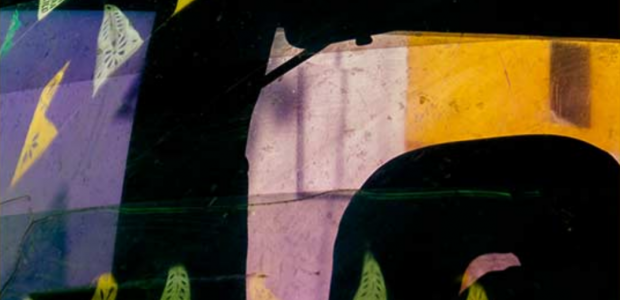
In September 2006, at Photokina in Cologne, Germany, a number of important announcements were made in the medium format industry that are still reverberating. Hasselblad announced that their H3 series cameras would no longer allow digital backs from other manufacturers to be used. Leaf and Sinar announced their adoption of the newHy6 cameraplatform, and Phase One announced that they were forming a strategic alliance with Mamiya.
Much has been written on this site about each of these topics during the past almost two years. Hasselblad’s decision, which I denounced then and still do (in part because I personally own a Hasselblad system consisting of two H bodies and five lenses) has probably not had the positive effects that the company had hoped it would, and in all likelihood, as reported by many Hasselblad dealers, has apparently had the opposite effect. The Hy6 came on the market earlier this year from both Sinar and Leaf. Availability of some AF lenses appears to be a concern though.
Earlier this year Phase One announced that they were going to be bringing out their own camera to be based on their new association with Mamiya, and in May first samples became available to dealers worldwide. (My report on the camera’s announcement is foundhere). In mid-June I had an opportunity to spend a week working with the new Phase One 645 camera and a P45+ back on a shoot in Newfoundland. The camera I used was the first off the assembly line with final production firmware, and was provided for testing by Kevin Raber, Phase One’s Marketing VP for North America. (I am told that pre-production cameras that were circulated during May and early June did not have final firmware, and any testing of them done should therefore be discounted. The production cameras are apparently much faster responding and smoother).
______________________________________________________________
Disclaimer
Kevin is a friend of mine and frequent shooting companion. I own and use a Phase One back on my Hasselblad system. Over the years I have owned a P25, P45 and currently a P45+. All were purchased at retail from the Canadian distributor Vistek. I am offered nofreebies, and wouldn’t accept any even if they were. And for the record, Kevin and I became friendsafterI bought my first Phase One back, not before.
So – because we are friends, are my reviews of Phase One products biased? That’s for you to decide. If you asked Kevin he’d probably tell you that I give the company a harder time than I might normally to prove that I’m not influenced by our relationship. I like to think that I simply try and give an honest appraisal of all products that come my way. Enough said.
______________________________________________________________
The Camera Package
The Phase One 645 camera is aMamiya 645 AFDIIIwith a Phase One logo on it. That’s it. No magic formulas, no special features, no unique firmware. The back mount on the cameras is a standard Mamiya mount and any Phase One back with a Mamiya interface can be used on it. In fact, any Mamiya mount back from any manufacturer, including Hasselblad, Sinar, and Leaf (and of course Mamiya itself) can be used on it. The Mamiya / Phase One camera is an open platform, the interface is non-proprietary, and any film or digital product from other manufacturers can be attached without license fees.
The Phase One 645 (and its twin the new Mamiya 645 AFDIII) are based on the previous Mamiya AFDII. All existing lenses and accessories are both backwards and forwards compatible between the old and the new models. The new camera has seen quite a few changes though, most of them for the better, and we’ll look at how the old and new models differ.
The camera comes in a fitted Pelican style case complete with a Phase One back of your choice, and a new-style 80mm f/2.8 lens. (This is the "Value Added Package", which includes a 3 year up-time warranty on the back, and 300,000 actuation warranty on the shutter mechanism). The case is airline carry-on legal size, though sturdy enough to be checked as luggage (which I did without ill-effect when flying back from Newfoundland to Toronto). The camera comes completely assembled in the case with all accessories. Among these are a Firewire card reader, a CF card, Firewire cable for tethered shooting, a second back battery and a second camera battery holder for the camera, along with Capture One 4.1 software. Simply insert a Lithium Ion battery in the back (one of two supplied), six AA batteries in the camera grip, and start shooting. Packaging and presentation are first rate.
I should add that there is a quick start reference guide that is among the best presented and designed that I have ever seen. It takes the form of sixteen 6 X 19mm laminated cards bound together with a swivel screw. This is much like the kind of thing one finds with paint samples. Additional documentation in PDF form is provided on an included 1GB memory stick rather than a CD. Slick.
Oh yes, and the kit also comes complete with a Hasselblad V series lens adaptor, so that anyone with a stable of older Hasselblad lenses can start using them on the Phase camera without delay or additional expense. Nice.
Overall I judge this to be the most attractive and useful medium format camera / digital back presentation that I’ve yet seen. Not quite up to Apple’s class-leading packaging standard, but damn close.
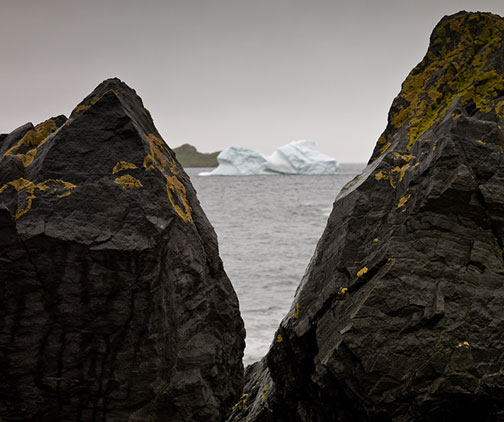
Rocks, Algae and Iceberg. Trinity, Newfoundland. June, 2008
Phase One 645 with P45+ back and 55-110 f/2.5 @ISO 100
______________________________________________________________
The Camera vs the AFDII
Mamiya 645 cameras are ubiquitous – one of the most popular medium format cameras on the market for many years, for use with both film and digital backs. The Phase One 645 builds on that heritage, but has been improved over the 645 AFDII in a number of ways. Among the six of us on this shoot we had two 645 AFDIIs so I was able to compare the models at some length.
For those unfamiliar with the basic Mamiya gestalt, it is a straightforward design with an integrated non-removable metering prism. There is a bayonet lens mount, and all Mamiya lenses, both AF and manual focus, are compatible. The AF motor is in the body and the camera features a focal plane shutter.
Both the Hasselblad and Hy6 systems use leaf shutter lenses. This make the lenses larger and heavier but is something that many photographers require because of the ability to sync with flash at any shutter speed. Phase recognizes this issue and has announced that a line of leaf shutter lenses will be made available, with at least one to ship before the end of 2008, and more to come. Be aware though that because the interface design of these leaf shutter lenses has not been finalized at this time it will be necessary for anyone with a Phase One 645 camera bought before the first leaf lenses ship to return the camera to Phase One for a minor firmware update. This will be performed without charge. There is currently no means for doing firmware upgrades oneself.
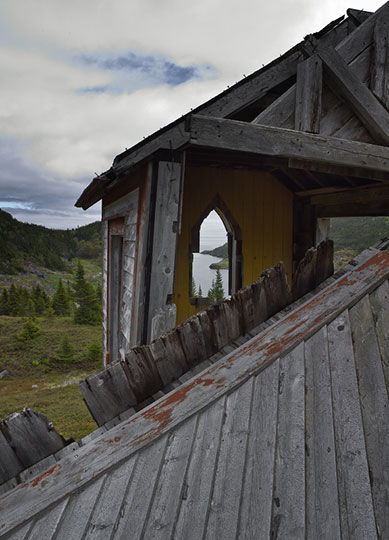
Church Ruin. Ireland’s Eye, Newfoundland. June, 2008
Phase One 645 with P45+ back and 35mm lens @ ISO 50
______________________________________________________________
Cosmetics & Changes
Since the previous generation Mamiya 645 cameras have been around for so long in relatively large numbers it’s likely of interest to many photographers to learn how the Phase One 645 camera compares, and what changes, improvements and otherwise, have been made.
The most obvious difference between the two is that the new camera has a matte finish rather than the shiny plastic previously seen. This gives the product a more professional look, but more importantly makes it less slippery. The grip has been totally redesigned and is much more ergonomic, with a very comfortable rubberized surface and larger gripping area.
The next obvious change is to the prism housing. On the previous model there were settings dials on the prism whose functions have now been moved to the top grip panel next to the LCD screen. A self timer position has been added to the ring around the shutter dial and the self timer has been placed where the MLU used to be. Overall a more sensible design. On previous Mamiya’s when mirror lock up was engaged one had to move to manual focus before the shutter would release. On the Phase One 645 this is no longer necessary.
The AF mode dial on the bottom font left of the camera has also been changed for the better, with a new design that has a finger notch, making it easier to set.
One change which seems to be somewhat less ergonomic is the move of the exposure compensation dial from the side of the prism, where it was an analog control with a locking position, to the top panel where it is now modal, used in conjunction with the LCD display. The positioning of the button and the need to look down on the LCD makes it somewhat less easy to use, and the finger moves needed to actuate it can be awkward when the camera is tripod mounted at eye level.
The metering pattern control has also been changed from an analog dial to a modal button on the top panel, and is now set with the aid of the camera’s LCD. Not to make to fine a point of it, but it moves the Mamiya / Phase design more towards the Canon gestalt of modal buttons than the Nikon approach where many controls are still analogue in nature. It’s a matter of personal preference, I know, but my taste is more toward traditional controls which can be viewed at a glace and whose settings are less ambiguous. Akin to the difference between telling time from an analog watch and a digital one.
It’s worth noting that this less mechanical interface will allow Phase One to move in future toward greater interoperability between the back and the camera body. This existed in the past on the Hasselblad H1 / H2 because Phase One helped Hasselblad design that camera’s original interface. I think we can assume that the same thing will happen now with Mamiya.

Across The Bay. Trinity, Newfoundland. June, 2008
Phase One 645 with P45+ back and 300mm lens @ ISO 100
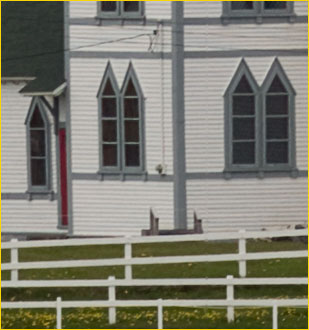
100%
At a distance of about a half mile the 300mm lens is easily able to resolve
individual telephone lines and dandelions, even with a low contrast subject.
Not externally visible, but worthwhile nonetheless, are a new coreless autofocus motor better able to move the larger elements in current and forthcoming zoom lenses. Apparently autofocus has also been upgraded with new algorithms so as to achieve faster AF.
______________________________________________________________
Issues
During a week of use in the fog rain and sea mist of Newfoundland I had no real problems with the Phase One 645 or its attached P45+ back. I complained once again about the lack of rubber plugs on the back’s openings (which I’ve been regularly doing for the past two years) and was rewarded with an emailed photograph of plugs which will soon be available. Apparently they will be included with all new shipping backs as soon as they are in full production. No word on price yet for prior owners, but I can’t imagine that they will be too expensive.
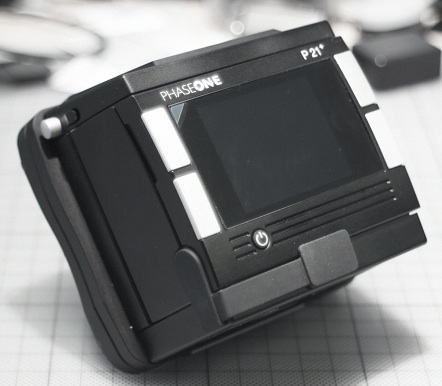
A more real concern is a problem with the way in which mirror lock-up works. When set to the MLU position the first press of the shutter release (button or via electronic cable release) moves the mirror up, and the second actuates the shutter. What I quickly discovered is that if you press the shutter button the second time for a fraction of a second too long, the mirror will pop up again after the exposure rather than simply return to the viewing position. This must have happened to me 20 times in one week, so it’s clearly more than just an occasional issue. According to Phase One this problem was missed during initial testing and will be corrected as production of the camera ramps up.
I was also a bit frustrated by how the MLU and self timer work in combination. One turns on the self time and selects the duration, from 2 seconds to 60 seconds. So far, so good. But then to take a shot with MLU one needs to press the shutter release to raise the mirror, and then press it again to activate the self timer. Once I understood how it worked, it worked, but it was annoying to have to remember to press the release a second time, unlike any other camera with which I am familiar, all of which only require one press.
Another area where I feel the Phase One (Mamiya 645 AFDIII) design doesn’t match the competition is its lack of a full-text display capability on its somewhat small LCD display. This really becomes an issue when it comes to setting custom functions. On an H Hasselblad, for example, one doesn’t need a manual or crib sheet to know what each function does, and all DSLRs now have rear-LCD full text function descriptions, some even with "help" paragraphs accessible. Phase One does provide itspaint samplestyle pocket information cards, which list all 35 custom functions, but it’s still not as useful as having them visible on the camera’s screen. Hasselblad’s implementation of this is much preferable. One can only assume that future generation Phase One cameras will correct this through a higher level of back / body integration, similar to that found in DSLRs.
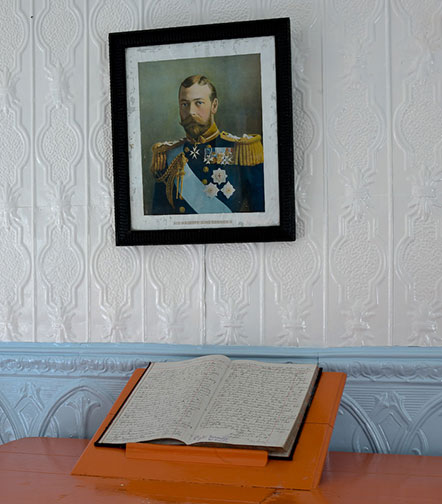
King George. Orange Lodge, Herring Neck, Newfoundland. June, 2008
Phase One 645 with P45+ back and 55-110 f/2.5 @ISO 50
75mm for 2 seconds @ f/11

100%
The combination of Mamiya glass together with a P45+ back
leaves little to be desired in terms of resolution.
For those not familar with the fundamental Mamiya / Phase One 645 design, the prism is not removable. Those on the Hasselblad and Hy6 are, and this may prove to be an issue for some users. It really depends on whether or not you need a waist-level finder. Just be aware that for many applications a WL finder on a 645 camera is, of course, impossible to use for verticals.
Update:I have been reminded that the Sinar Hy6 has a rotating back adaptor available as an accessory. This allows the back to be placed in either a vertical or horizontal position, making a waist level finder practical for some photographers. The reason that this is possible is because the Hy6 is actually a 6X6 format system.
The Phase One camera body uses six AA cells. There is at the moment no rechargeable battery grip insert option, though I was told that one is in development. Of course rechargeable AAs can be used as a cost saving measure. I did not have the camera long enough to discover what the battery life with regular alkaline batteries is, though Phase One claims about 3,000 captures at room temperature.
There is no provision for a wrist strap. I feel that cameras of this weight should have some sort of wrist support, and given that the Phase 645’s grip is a new design it’s a surprising omission that one wasn’t included. The company says that they are looking at a wrist strap option as well as a range of additional accessories, such as lens mount adaptors for Pentax and Contax.
One final issue remains a bit unclear as I write this the week following testing in Newfoundland. For the first two days I shot extensively with the 75-150mm lens without issue. Then on the third day it had problems when first mounted on the camera, refusing to electronically actuate the aperture reading in the camera. This could be solved by popping the camera’s batteries in and out. Thinking that it was a problem specific to that particular lens we tried another sample of the 75-150mm which Bill, one of our trip members, was using on his AFDII. It exhibited the same problem. Both lenses worked fine on the AFDII, so it wasn’t the lenses, but this doesn’t explain why there was not a problem for the first few days. Phase One is investigating this issue.
______________________________________________________________
Lenses
Both Hasselblad H series cameras and the new Hy6 use leaf shutter lenses. The Phase One / Mamiya cameras use a focal plane shutter. This is a good news / bad news situation, both ways. Leaf shutters potentially add to the cost and most definitely to the bulk of the lens. I’m used to my H series lenses and working for a week with Mamiya lenses on the Phase One camera was a revelation. It may not be a big deal in the studio, but for location work the smaller size and weight of lenses that don’t have shutters built in is a real bonus.
One theoretical advantage to leaf shutter lenses is that if a shutter fails one can still keep shooting with another lens. On a focal plane shutter camera a shutter mechanism failure means switching to a back-up body or heading home. Of course leaf shutter lenses have flash sync at all shutter speeds, while medium format cameras have much slower sync speeds than do DSLRs.
Of course an advantage of a focal plane shutter is that shutter speeds remain consistant when switching lenses, since multiple shutters are not in use. The Phase One shutter also goes to 1/4000 sec, which is considerable faster than any leaf shutter can be made.
Given that Phase One and Mamiya have some leaf shutter lenses coming, this will mean that most photographer’s needs and interests will be met. There is a leaf shutter 80mm lens due in the fall (2008) and additional focal lengths are in development.
I was also told that Mamiya has a tilt / shift lens in the works. There have been rumours of a Hasselblad T/S lens since before Photokina 2006, but nothing yet. I fear that if and when it does come it will be H3D compatible only, which means that H1 and H2 owners like me will be frozen out. For photographers without a technical or view camera to put their backs on a T/S lens is a very worthwhile thing to have. In the meantime theHartblie 45mm Superrotatorlens is available in Mamiya and Contax mount, but not for Hasselblad or the Hy6.
I didn’t do any serious lens testing on my Newfoundland shoot. I simply did some critical photography. I had the new Phase One branded 80mm f/2.8 as well as the Mamiya 28mm, 35mm, 55-110mm, 120mm Macro, 210mm and 300mm. All performed very well, and I wouldn’t hesitate to use any of them for any application or assignment. I did notice some corner fringing with the 28mm, and was told that Capture One 4 is designed to deal with this, but I did my raw processing in Lightroom 2.0 and found that its defringing tools did a fine job as well.
Mamiya has had a decades-long reputation for making high quality medium format optics. I don’t have enough personal experience with them to make any pronouncements, but I know many pros who use them daily and have good things to say. I also know at least one world-class landscape photographer who did careful testing about a year or so ago between Hasselblad and Mamiya lenses before moving from 4X5" film to medium format digital, and he found little to choose between them in terms of image quality. He ended up going with Mamiya as it was less expensive.
One thing which I like about several of the Mamiya lenses, particularly the zooms and longer ones, is that switching between MF and AF is performed by sliding a wide ring located around the lens forward and back. This is much more convenient that fumbling for a small switch on the body or lens.
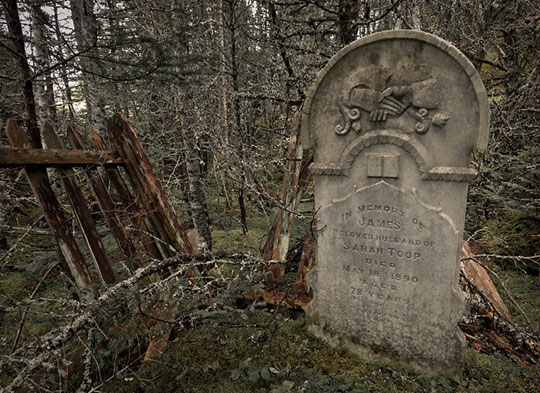
Gravestone. Ireland’s Eye, Newfoundland. June, 2008
Phase One 645 with P45+ back and 28mm lens @ISO 50
0.7 seconds @ f/11
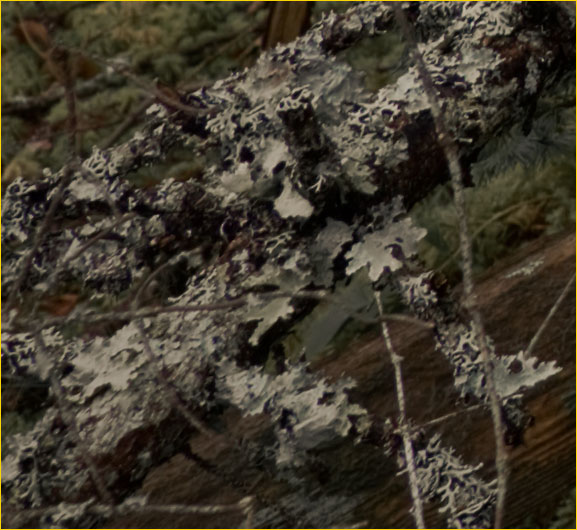
100% – lower left corner
The edges of frame on the new 28mm lens are quite good. Lenses this wide
in 645 format are notoriously difficult to design well, but even when processed
in Lightroom 2.0 (which doesn’t have some of the lerns correction tricks built into
Capture One 4.1) which comes with the system, edge and corner results are quite acceptable.
______________________________________________________________
The P45+
I’ve been working with Phase One’s P series backs since they first were introduced, and own a P45+ which I use on my H2 Hasselblad, so there was little new here for me to test. Needless to say the back produces some of the finest quality files that I have ever seen. There may be backs from other companies that match it, but none that I have tested (and I’ve tested them all) that exceed it. Of course the Phase One camera is available alone, or with any of the company’s other P backs.
Gripes? Yes, a few. Though the Plus series LCD screen is a step up from the truly abysmal screen on previous Phase backs, they are nowhere near as good as those now found on $300 pocket point and shoots. This is something that continues to frustrate me.
Battery life on the back is not as good as I would like. I usually bring at least three batteries on an all-day shoot. I guess those large CCD sensors are power hogs. Hasselblad addressed this issue by having their new H3D’s camera battery power both the back and camera, which is a very nice design, though this makes using the back on a technical camera somewhat problematic because of the lack of a self-contained battery. I suppose there’s no simple solution unless a switch to CMOS is made, but that has other implications. This is a subject for a future discussion.
______________________________________________________________
The Take Away
So – what’s the take away on the new Phase One 645 camera? If you like the Mamiya 645 design, you’re likely going to love the Phase One 645. It and its twin the Mamiya 645 AFDIII are a definite improvement over previous Mamiya 645 series models. As discussed above, handling has been improved in most areas, and there are numerous under-the-hood changes that make the camera more robust, reliable, and faster responding.
This begs the issue of who this camera is for. If you currently own a Mamiya 645 system and lenses and want to move to a medium format back and updated body, then the choice of the Phase One 645 is a no-brainer. This assumes of course that you’ve decided on a Phase One back over the competition. If you want a Leaf or Sinar back then you can still consider a Mamiya-based camera solution, even a Phase One body.
If you have Hasselblad V series system and lenses the new Phase One camera provides you with an included V series lens adaptor, though of course these lenses won’t autofocus, and require stop down operation.
If you don’t own any digital compatible medium format camera at the moment and are looking to move to such a system then you have a number of choices. Selecting an H series Hasselblad means only being able to use a Hasselblad back, good as it is. End of story. If you want a Leaf back you can put it on a Hy6 camera, a Mamiya or Phase body, a Hasselblad H1 or H2 (used), or a Contax 645 (used). If a Sinar back is your preference then you can put it on a similar selection of cameras.
What it comes down to then is – choose your back first. It is the most expensive part of a medium format digital system. It’s the tail that wags the dog. Once you’ve tested, evaluated, and decided which back is for you, then choose your camera body and lens system. Some back choices give you lots of body options, some give you less, some give you none.
In the case of Phase One, clearly the company needed to have a camera system which it could call its own. Not being part of the Hy6 consortium, and being frozen out of the Hasselblad system (other than on discontinued V series and H1 and H2 bodies) Phase joined forces with Mamiya, and both companies as well as photographers will benefit from the relationship.
True to its word two years ago, Phase One’s new camera is an open platform. You can put a Leaf or Sinar back on a Phase One camera if you wish, and Mamiya makes their digital interface specification open to any company that wishes to make a back for that camera.
Even though we are now in the era of 20MP+ DSLRs from Canon, and soon Nikon and Sony, there is no getting away from the fact that the extra real estate of a 645 back with its larger photosites simply produces superior image quality. Landscape, fashion, event, and editorial photographers have always shown a preference for larger formats than 35mm, and in the digital era nothing has changed in this regard.
An interesting anecdote which I have now heard from a couple of source in the industry is that several large studio centers who switched from medium format to DSLRs a while back are now switching to MF digital again, simply because of the superior image quality which it can produce. It’s not just about megapixels, because in many cases these studios are producing images that will never end up being larger than a catalog or magazine page in size. It’s about image quality, pure and simple.
With the new Phase One 645 camera that company now has complete control over its camera platform destiny when it comes to meeting the needs of professional photographers and demanding amateurs. I think that it’s safe to assume that this model is just the first of what will be a major new camera and lens line, and the open platform philosophy and synergy between Phase One and Mamiya can only therefore benefit us all.
Phase One cameras and digital backs are available from VARs and professional photographic dealers worldwide. These dealers can supply Phase One lenses as well as Mamiya branded lenses, or Mamiya lenses and accessories may be purchased anywhere and used on a Phase One body. The Phase One 645 camera is now shipping.
June, 2008
You May Also Enjoy...
Whither Nikon
Illustration courtesy NikonLast week Nikon announced the first of a new series of lenses designed for the reduced image circle requirements of their D series
Why What Works (Rediscover)
FacebookTweet Figure #1 From The Bench. San Miguel de Allende, Mexico. December, 2012 Sony RX1 @ ISO 100 Why do some photographs succeeded and some
